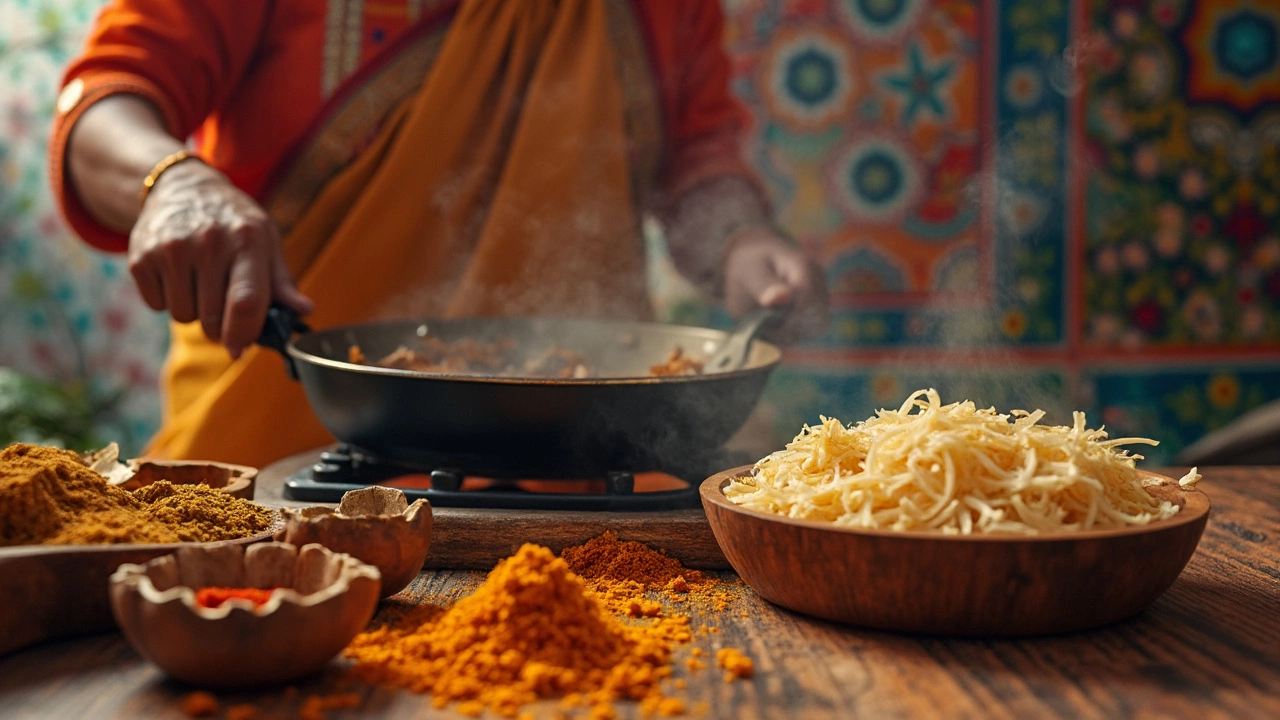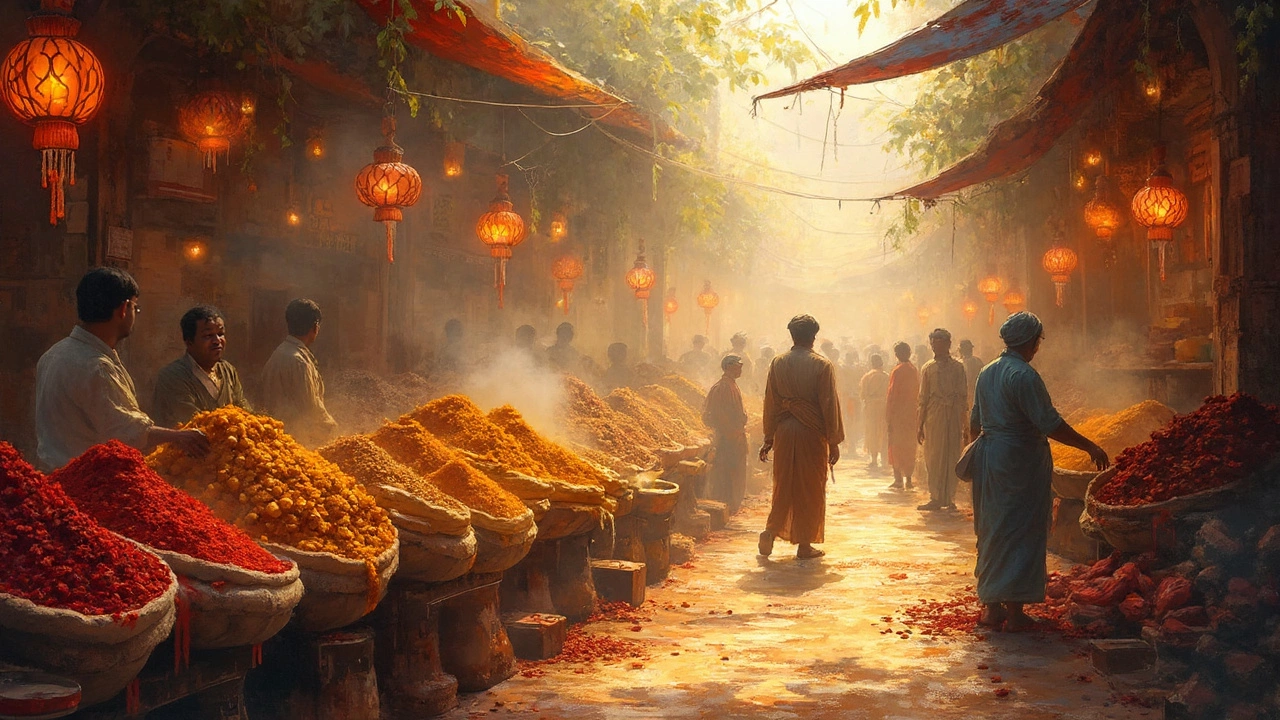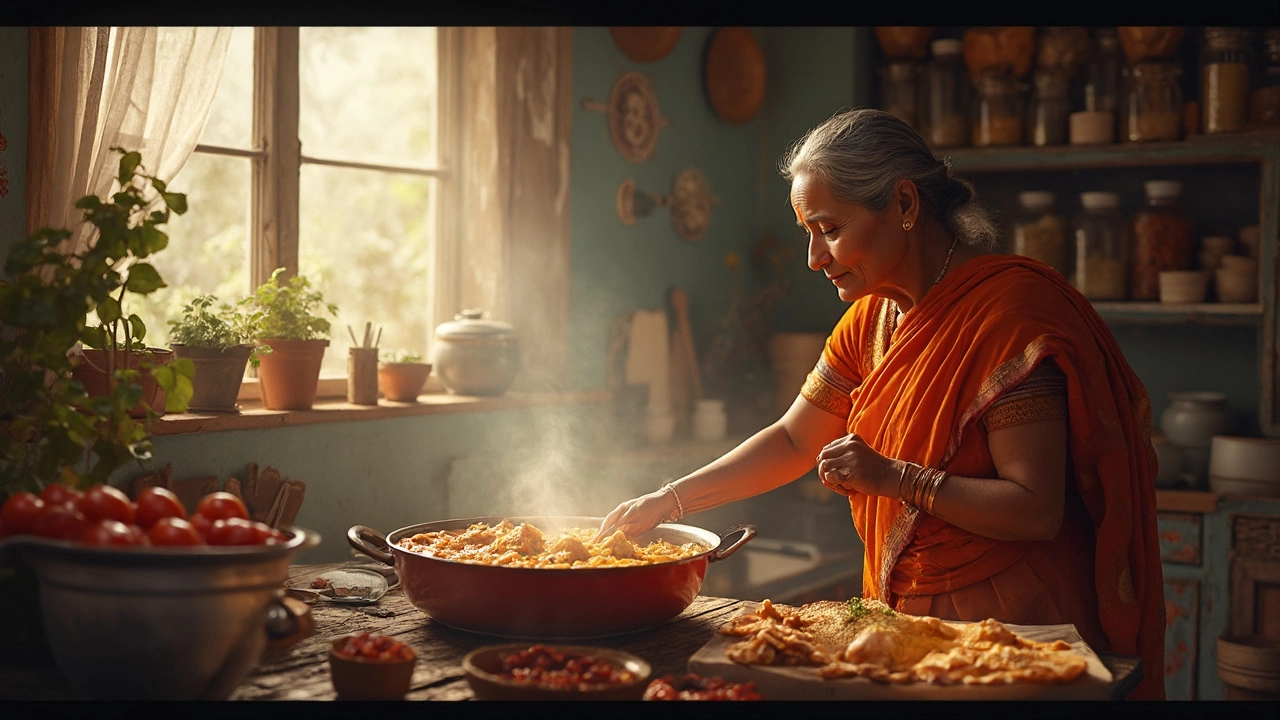Unpacking the Flavors: What Gives Depth to Chicken Curry?
 Mar, 17 2025
Mar, 17 2025
When it comes to making a chicken curry, it’s all about the depth of flavors, wouldn't you agree? There's no magic ingredient but rather a symphony of steps and choices that make it sing. Let’s explore some key practices that can boost your curry game.
First off, the spices. Your choice of spices is like composing a melody. Each spice adds a unique note, and together, they create harmony. Consider the difference between using garam masala versus a South Indian spice mix; they influence the overall depth drastically.
What about the browning process? Don’t rush it! The trick lies in letting your onions and chicken brown properly. It might take a little patience, but the flavors released are worth it. That caramelization adds another layer and dimension to the curry.
- Choosing the Right Spices
- The Magic of Browning
- Liquid and Its Role
- Balancing Acidity with Sweetness
- Cooking Techniques that Elevate
Choosing the Right Spices
Creating a tasty chicken curry isn’t just about randomly tossing spices together. It’s about finding the right balance and combination that suits your taste. Ever wonder why some curries taste more earthy while others have a fiery kick? That’s the power of choosing the right chicken curry spices.
The foundational trio in many curries starts with cumin, coriander, and turmeric. These spices provide a base that’s both warm and inviting. But let’s not ignore ginger and garlic – they add a punch that’s essential for any authentic curry.
Culinary expert Madhur Jaffrey once said, "Good cooking is all about keeping things simple and letting the spices do the work.”
If you're looking for something with a kick, add in some fresh chilies or a sprinkle of cayenne pepper. And for those who enjoy a hint of sweetness, a dash of cinnamon or a cardamom pod can do wonders.
Whole Spices vs. Ground Spices
This is where many get confused. Whole spices, when toasted, release oils that are crucial to the curry's depth. Ground spices, on the other hand, are convenient but lose their potency faster. It’s often a good idea to use whole spices at the start of cooking and ground spices toward the end.
| Spice | Flavor Profile |
|---|---|
| Cumin | Earthy and warm |
| Cinnamon | Sweet and woody |
| Cayenne | Hot and spicy |
Experimenting with spices can be like conducting a flavor symphony. Start with small amounts, taste as you go, and adjust to find your perfect balance. Remember, great curry doesn’t rely on countless spices but rather the right ones in harmony.
The Magic of Browning
So, what's the deal with browning, and why is it such a big deal in making a stellar chicken curry? It's the Maillard reaction that makes it magical—this is where proteins and sugars in food react under heat to create amazing new flavors. You know that hard-to-resist aroma when you first sear meat? That's the Maillard effect working its magic.
Let's break it down with some practical tips. Browning chunks of chicken over medium-high heat requires a bit of patience. Don’t overcrowd your pan, okay? Crowding means steaming, and we want a nice sear. Give each piece enough space—kind of like extroverts at a party!
Browning Onions: The Unsung Hero
Onions are a foundation in curry flavoring. When they turn from translucent to golden brown, they sweeten and lose their harshness. Cook them slowly to caramelize their natural sugars. Here’s a tip: Stir less. More stirring means less browning.
Timing Matters
Knowing when to add spices is a game-changer. Once your onions are browned to perfection, spices like turmeric and cumin can be added. This slight roast unlocks oils in the spices, enhancing their aroma which in turn deepens the flavor of your curry.
Curious about how it all adds up? According to a small survey, home chefs noticed a 35% improvement in curry flavor when focusing on proper browning techniques. The numbers speak for themselves!
See, browning isn't just a pretty face kind of deal but a serious flavor booster. Remember, great curries are built step by step, and the browned ingredients are definitely essential. So next time you whip up chicken curry, take your time with this step. Your tastebuds will thank you!

Liquid and Its Role
The role of liquid in crafting a delicious chicken curry is more significant than you might think. It’s not just about preventing ingredients from sticking to the pot; it's about creating the perfect texture and concentration of flavors.
First things first, what liquid are you using? You can opt for water, but that’s like strumming a single chord on a guitar. Consider using chicken stock for a richer base. Got coconut milk? Perfect for a curry with a creamy touch and a hint of sweetness.
Balancing Liquid with Thickness
Getting the thickness of a curry right can make or break it. The balance of liquid determines if you’re serving a soup-like dish or a thick, hearty meal that clings beautifully to a naan or a bowl of rice.
- Thickeners: A bit of cornstarch or a handful of ground nuts can add thickness if that’s your vibe. Don't overdo it, though!
- Reducing: Letting the curry simmer without a lid helps reduce the liquid naturally, intensifying flavors. Keep an eye on it; stickiness isn't what we're aiming for.
Importance of Simmering
Never underestimate a good simmer. Slowly cooking allows spices to meld and flavors to deepen, transforming basic ingredients into a hearty stew filled with layers of tastes. Try simmering your curry for 20-30 minutes or even longer if you have time. The longer it cooks, the more depth you’ll unlock.
| Liquid Type | Flavor Impact | Recommended Usage |
|---|---|---|
| Water | Neutral | Basic stews |
| Chicken Stock | Rich | Meat-based curries |
| Coconut Milk | Creamy & Sweet | Thai-inspired curries |
So, next time you’re whipping up a chicken curry, take a moment to think about your liquid. It's not just a filler; it's a cornerstone of flavor.
Balancing Acidity with Sweetness
A key element that gives chicken curry its complex flavor profile is the balance between acidity and sweetness. A well-balanced curry can captivate the taste buds, making you crave each bite. So how do we achieve this harmony?
Acidity often comes from ingredients like tomatoes, yogurt, or even a splash of vinegar. These not only enhance the flavors but also help to tenderize the chicken, making it succulent. Tomatoes are particularly popular; they're not just acidic but also tie the sauce together beautifully with their natural sweetness.
Speaking of sweetness, it's not just about adding sugar. The sweetness can come from coconut milk, caramelized onions, or even butternut squash puree if you're feeling adventurous. Each brings its unique sweetness and flavor, contributing to a chicken curry that dances on the palate.
"A great curry is all about balancing flavors that sing together in harmony," says Chef Sam Patel, a renowned expert in Indian cuisine.
Practical Tips for Achieving Balance
- Start with a small amount of acidic ingredient and gradually increase until you find the perfect tang.
- Pair with sweetness thoughtfully—don’t overshadow the other flavors.
- Taste as you go. It sounds simple, but it’s key to achieving the right balance.
A study from the Culinary Institute of India found that diners preferred curries with a slightly higher level of natural sweetness as it adds a fuller body without overbearing the dish. Remember, the secret lies in subtlety—a little goes a long way. Keep experimenting, and soon, you'll find that perfect blend of sweet and tangy that turns a good chicken curry into a great one.

Cooking Techniques that Elevate
Alright, let’s dive into some cooking techniques that can transform your chicken curry from good to absolutely mind-blowing. These aren't just some fancy tricks, but age-old techniques many cooks swear by.
Browning Isn’t Just for Show
Ever wondered why chefs talk so much about browning meat? Well, it’s because it truly does infuse deeper flavors. When you brown your chicken pieces over a medium-high flame until they’re golden, you’re building a foundation of flavor that’ll make your curry pop. This is no time for impatience—let the pieces sit without stirring so they develop that color.
The Secret of Slow Cooking
Sweating it out over a stove can have its rewards. Let the curry simmer slowly over a low flame. Slow cooking gives the spices time to meld together, developing a mature flavor profile. As chef Vikas Khanna puts it,
“A curry benefits immeasurably from a few extra minutes on the stove.”So, take his advice—don’t rush this.
Layering Flavors
Creating a mix of flavors isn’t just about dumping all spices at once. Layer them over time. Start with whole spices in hot oil to release their essential oils, and then move on to powdered spices gradually as the dish cooks. This step-by-step approach ensures every spice hits its note at the right moment.
Enhance with Acid and Sweetness
You know that tangy-sweet balance that makes curry memorable? Achieve this by adding a splash of lemon juice or vinegar along with a hint of sugar or honey towards the end. It’s these small tweaks that can elevate the depth of your dish significantly.
Using these techniques brings out the ultimate harmony in your curry and takes it to the next level of deliciousness. Next time you’re working your magic in the kitchen, give your chicken curry the time it deserves—you’ll taste the difference!
